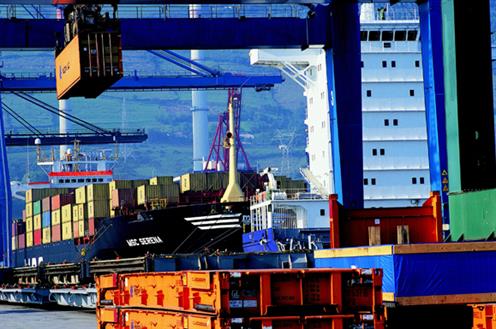The coverage rate (exports over imports) stood at 90.5% (92.5% in January-July 2017). In terms of volume, exports grew by 1%, since prices measured by Unit Value Indices rose by 2.8%; while imports grew by 2.7% following a 3.4% price rise.
The non-energy balance posted a deficit of 3.36 billion euros (versus a surplus of 88 million euros to July 2017). In turn, the energy deficit rose by 9% to 14.47 billion euros (compared with a deficit of 13.28 billion euros in January-July 2017).
Spanish export growth between January and July (up 3.8%) was slightly weaker than in the Eurozone as a whole and the European Union (4.9% year-on-year in both cases). The highest export growth figures were posted by Germany (up 4.5%), France (up 4.6%), Italy (up 4.2%) and the United Kingdom (up 4.7%). Exports also increased in the United States (up 9.6% year-on-year), China (up 12.6%) and Japan (up 5.9%).
All sectors reported export growth, except the food, drink and tobacco sector, which accounts for 16.2% of the total and fell by 0.2% year-on-year. Capital goods (19.7% of the total) grew by 1.6%; the automotive sector (16.7% of the total) grew by 2%; and chemical products (14.3% of the total) grew by 4.2%.
All sectors also reported import growth, except consumer manufactures (accounting for 11% of the total), which fell by 0.5% year-on-year. Thus, imports in the capital goods sector (20.7% of the total) increased by 3.1%; in chemical products (15.3% of the total) by 7.5%; in energy products (14.3% of the total) by 12.2% year-on-year; and in the automotive sector (13.5% of the total) by 7.2%.
Exports to the European Union (66.1% of the total) grew by 3.7% in the first seven months of the year. Exports to the Eurozone (51.9% of the total) increased by a larger amount, 3.9%, and exports to the rest of the European Union (14.2% of the total) grew by 3%.
This growth was even greater in terms of exports to non-EU countries (33.9% of the total), which increased by 4.1% in this period. Export growth was recorded to all major regions: Oceania (up 13.1%), Africa (up 5%), North America (up 2.5%), Latin America (up 2.2%), Middle East (up 1.1%) and Asia excluding the Middle East (up 0.3%). By country, it is worth noting the export growth figures to Argentina (up 31%), Algeria (up 21.7%), Egypt (up 20.7%), Indonesia (up 20.5%), Australia (up 20.4%), Saudi Arabia (up 8.6%), Morocco (up 7.8%), Chile (up 6.1%) and the United States (up 3.9%), while exports decreased to United Arab Emirates (down 18.3%), Peru (down 16%), Hong Kong (down 11.4%), Nigeria (down 11%), Canada (down 7.7%), Taiwan (down 7.2%) and South Africa (down 5.5%).
The autonomous regions posting strongest export growth were Navarre (up 11.4%), the Basque Country (up 10.5%) and Galicia (up 9.9%). In contrast, the largest decreases were posted by Asturias (down 6.4%), the Region of Madrid (down 3.4%) and Aragon (down 3%).
Figures for July
In July, Spanish exports of goods increased by 9.8% on the same month in 2017 to 24.36 billion euros, the highest year-on-year growth in July since 2011. Imports increased by 13.6% year-on-year to 27.6 billion euros, the highest year-on-year figure for this month since 2010. As a result, a deficit of 3.25 billion euros was posted in July 2018, 54.7% higher than in the same month of 2017. The coverage rate stood at 88.2%, 3.1 points less than in July 2017. The seasonally-adjusted series corrected by the calendar effect saw export growth of 6.8% year-on-year and import growth of 10.3%.
The non-energy balance posted a deficit of 1.01 billion euros (versus a deficit of 175 million euros in July 2017) and the energy deficit grew by 16.1%.
Spain's export growth in July (up 9.8%) was higher than both the Eurozone (up 9.4%) and the European Union (up 9%). Lower export growth than in Spain was also posted by Germany (up 7.6%), Italy (up 6.8%) and the United Kingdom (up 5.4%), while exports from France posted a higher figure (up 13.9%).
The main contributions to export growth came from the energy products sector (which contributed 3.2 points), capital goods (up 1.8 points), raw materials (up 1.5 points) and chemical products (up 1.2 points). No sector contributed negatively in July.
In July 2018, exports to the European Union accounted for 63.4% of the total (63.5% in July 2017) and grew by 9.6%. Exports to the Eurozone grew by 9.4% while those to the rest of the EU increased by 10.5%. Of our main trade partners, strong export growth was posted by France (up 16%), Portugal (up 9.8%), the United Kingdom (up 8.3%), Italy (up 6.4%) and, to a lesser degree, Germany (up 1.7%). Finally, exports to third countries (non-EU) accounted for 36.6% of the total and grew by 10% year-on-year.
The full report can be consulted on this website:





